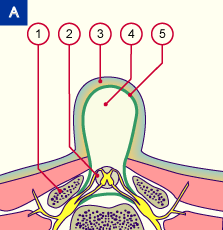
1
2
3
4
5 |
Spinous process
Spinal cord
Mostly intact skin over the
meningocele
Meningocele with cerebrospinal
fluid
Dura mater |
|
|
|

4
2
3
4
5
|
Vertebral arch
Spinal cord
Mostly intact skin over the
meningocele
Meningocele with cerebrospinal
fluid
Dura mater |
|
|
|
Fig. 30; Fig. 30a
Schematic drawing of a meningocele. The spinal cord is in its normal location. Only a sack filled with cerebrospinal fluid, bounded by the dura mater, protrudes from below the skin.
|